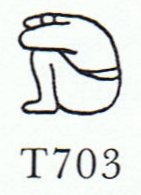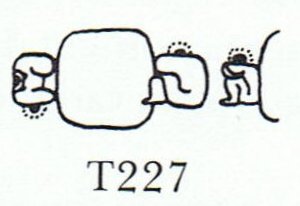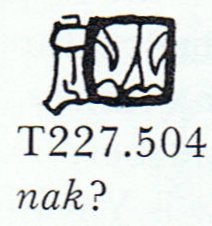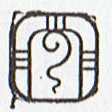|
TRANSLATIONS
Looking for more information about the Skeleton constellation I find another interesting item: "... he [Barthel] suggests that T570 (P1b) is the equivalent of proto-Maya *baaq 'bone' (Yuc. baac). This is one of the Palenque EGs [Emblem Glyphs], and the identity of the glyph as a bone has long seemed likely. Another of the Palenque EGs, T1040 (P1a), is a skull, and Barthel suggests reading tzek (Yuc. 'skull') ..." (Kelley) This gives food for thought. The four bacabs (plural of baac) means the 4 bones. These 4 'bones' are necessary to 'raise the sky roof up to let in the spring light'. Yet Metoro said vae kore (no legs) at the glyph type I have guessed represents baac:
But legs (va'e) are not bones (ivi):
The bones (former legs) of the old generation are necessary to raise the sky. The bacabs are no young 'roosters' in spite of the words of Metoro:
Though we can accept his view because the young generation is the rejuvenated old generation, according to the view of Popol Vuh: ... And then she looked in her hand, she inspected it right away, but the bone's saliva wasn't in her hand. It is just a sign I have given you, my saliva, my spittle. This, my head, has nothing on it - just bone, nothing of meat. It's just the same with the head of a great lord: it's just the flesh that makes his face look good. And when he dies, people get frightened by his bones. After that, his son is like his saliva, his spittle, in his being, whether it be the son of a lord or the son of a craftsman, an orator. The father does not disappear, but goes on being fulfilled. Neither dimmed nor destroyed is the face of a lord, a warrior, craftsman, an orator. Rather, he will leave his daughters and sons. So it is that I have done likewise through you. Now go up there on the face of the earth; you will not die. Keep the word. So be it, said the head of One and Seven Hunaphu - they were of one mind when they did it ... Tzek means 'skull' we also learn, i.e. the name of the 5th month, the month announcing the birth of summer:
What does it mean? Possibly it is a reference to the head of the baby being born, the first part out into the light. Later, at high summer this head will be very high up. Let us move on with the documentation of the '13 heavens': "The sixth locality is the place of crossed bones, interpreted by Barthel as a cist; it is interesting to find it represented by the little figure without a normal head (T227, probably the same as T703), which frequently appears in astronomical contexts.
T227 also appears with the head of the muan bird as the glyph for the muan bird's head, as a place." (Kelley) T703 indeed looks like the right part of the 6th heaven glyph:
The 6th heaven is evidently located at autumn equinox, I think. The 'head' is sinking down (look how the Rain God points down) - or already lost as in T703 - and it it the time of the Muan owl. T227 is a somewhat more complicated - but clearly related - glyph:
The black symbol where the head normally is, could refer to the last phase of a fire, when only the smoke is left:
"Three representations of a deity smoking a tubular pipe appear on Madrid pages 86-87b. The initial glyger in the accompanying text is T227:504; Seler pointed out that this glyger probably meant 'smoking'. T227 is a seated man; nak in Tzotzil is 'to sit'; the second glyph is the well-known glyph for 'night', Yucatec akbal.
Knorozov ... reads T227 as nak, citing only Yucatec nak 'belly'. For the combination T227:561:23, Knorozov ... read nak chaan, citing Motul nak caan 'capa del cielo' ('layer of heaven'), a plausible reading. T504, the akbal glyph, is read by Knorozov simply ak. Cordan ... follows this reading completely, giving nakak 'to smoke'. This seems to be entirely a derived meaning, for which he cites the comparative evidence of Yucatec nakba 'to burn' and Chontal nuk'um 'he smokes'. If the latter is due to assimilation from an earlier *nak'um, it would certainly support the reading of T227 as nak, although not necessarily the interpretation of T504 as ak. Tzeltal nak' 'to hide' may account for the use of this glyph in astronomical contexts, where it may indicate occultation." (Kelley) The primary astronomical occultation occurs each day in the evening. During the beginning of the year the sun is 'barred', the sign of which occurs also in the glyph for 6th heaven:
The rectangular 'bone container' on which the Rain God squats has the sun eye in the middle, and twice 2 bones surrounding. These ends of these bones look like the 'fist' ('head') of vae kore:
The 'mouth' is open, the old bones are talking. The 'light' is coming out through their open mouths. The Muan has closed her beak, though, and the words (nak' to hide, nuk'um he smokes etc) do resemble the strange Polynesian word nuku.
The 'land' (nuku) could be the 'earth' (caban) on which the Rain God sits and into which sun goes down. First comes the owl (Cib, Muan, Ruru etc), and then it goes completely dark
|



























